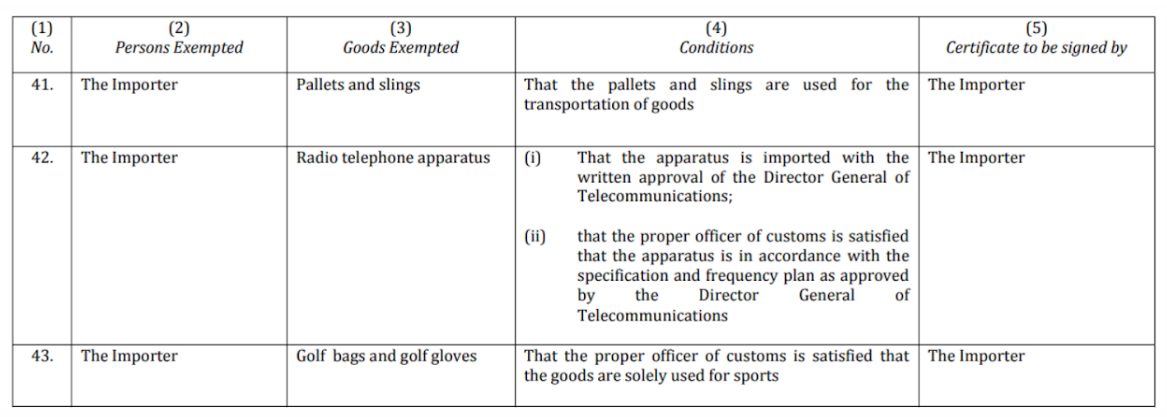Grow your business with the Discover newsletter
Logistics advice & insights straight to your inbox
Subscribe now
Import duty, also referred to as Customs Duty, is a duty charge imposed on goods entering Malaysia from oversea via road, sea, or air. This duty, along with excise duty and sales tax, contributes to the overall charges on imported items.
Import duty is charged either on an ad valorem basis (as a percentage of the value of the goods) or on a specific basis (as a fixed sum of money per unit).
Import duties are calculated as a fixed percentage of the value of the goods, ranging from 0% to 60%. For example, if the rate is 20% and the value is RM 10,000, the duty would be RM 2,000.
Examples of goods:
HS Code | Description of goods | Rate of Duty |
0810.90.20 00 | Lychees | 30% |
1604.31.00 00 | Caviar | 8% |
1704.90.20 00 | White chocolate | 15% |
2103.90.11 00 | Chilli sauce | 10% |
2201.10.10 00 | Mineral waters | 20% |
4818.10.00 00 | Toilet paper | 25% |
6211.43.10 00 | Surgical gowns | 5% |
Import duties are a fixed sum per unit or quantity of goods, regardless of their value. For example, if the rate is RM 5 per kilogram, the duty would be RM 500 for importing 100 kilograms.
Examples of goods:
HS Code | Description of goods | Rate of Duty |
2204.10.00 00 | Sparkling wine | RM23.00 |
2402.20.20 00 | Clove cigarettes | RM0.20 per stick |
2206.00.20 00 | Saké | RM25.50 per 100% vol. per litre |
You can refer to the Customs Duties Order 2022 to view a comprehensive list of goods and their corresponding import duty rates, or you could also learn about the import duty applies to you good when you verify your goods HS code, customs paperwork, and landed cost using DHL MyGTS.
Certain individuals and goods are eligible for import duty exemptions. You can refer to the Customs Duties (Exemption) Order 2017 to determine eligibility and specific goods exempted.

Here is a guide to navigate the table of exemptions:
2nd Column: Individuals or organizations who are eligible for the exemption mentioned in the 3rd column
3rd Column: Goods eligible for exemption
4th Column: Exemptions conditions for mentioned goods
5th Column: Individuals responsible for furnishing exemptions certificates
The import duty exemption will be granted once the proper customs officer approves the certificate.
To determine the import duty on your imported goods, you need two key pieces of information:
HS Code (a code that identifies the type of goods)
Import Duty Rate
Begin by determining the precise HS code for your products. This can be done through the tariff searching tool by Malaysia's official customs or DHL customs tool, MyGTS.

To calculate the import duty, multiply the CIF value (total sum of cost, insurancem and freight) by the import duty rate.
The formula looks like:
(Cost + Insurance + Freight) x Import Rate = Import Duty
Import duty rate varies by goods. Check the rate on JKDM's site using the HS code or get a quick estimate from DHL MyGTS.
Formula: CIF value x Import Duty Rate = Import Duty | |
Scenario | Goods: Pocket Motorcycle HS Code: 87.11.20.93.00 Import Duty Rate: 30% |
Calculation | RM 5,000 × 30% = RM 1,500 |
Import duty of pocket motorcycle | RM1,500 |
After making the necessary declarations using the Customs Import Declaration Form No. 1 (K1 form), you must promptly settle the assessed import duty for the goods to be released from customs control.
There are 2 payment methods for import duty:
1. Over the Counter (at Customs Import Offices)
Importers have the option to make payments directly at customs import offices.
2. Third-Party Appointed Platforms
Using third-party platforms for payment is another option. Service providers like ePayment, eDagangNet, and similar entities make import duty payments secure and efficient.
However, in most cases, the payment process is facilitated by an appointed customs agent. Once the shipper provides all the necessary shipment documents, the agent can efficiently handle the payment on behalf of the importer.